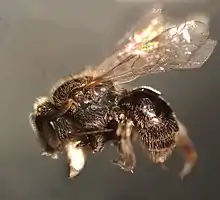Dialictus
Dialictus is a subgenus of sweat bees belonging to the genus Lasioglossum. Most of the members of this subgenus have a metallic appearance, while some are non-metallic.[2] There are over 630 species worldwide. They are commonly found in the Northern Hemisphere and are found in abundance in North America.[3] Members of this subgenus also have very diverse forms of social structure making them model organisms for studying the social behavior of bees.[4]
| Dialictus | |
|---|---|
 | |
| L. obscurum/L. planatum | |
| Scientific classification | |
| Kingdom: | |
| Phylum: | |
| Subphylum: | |
| Class: | |
| Order: | |
| Family: | |
| Genus: | |
| Subgenus: | Dialictus |
Morphology
Members of Lasioglossum (Dialictus) are small, about 3.4–8.1 mm in size, and distinguished from other halictids by a strongly arched basal vein and weakened distal veins on the forewings.[4] Distinguishing between some of the species in Lasioglossum (Dialictus) proves to be difficult due to their “monotonous” morphology and subtle differences.[3][2] Some species have been named based on geographic distribution and ecological niche rather than using any distinguishing morphological features.[5]
Molecular
Genetic barcoding has developed into a commonly used identification tool for taxonomists, though Lasioglossum (Dialictus) lacks a distinct barcode gap.[6] In addition to this group's subtle morphological differences, this causes identifications to be misleading or difficult to ascertain.
Ecology
Solitary vs. communal
Though solitary bees such as Lasioglossum figueresi often live in proximity to each other, unlike communal bees, the nests of solitary bees are built by lone females. The female builds the nest and feeds her offspring without workers or help from other bees.[3] Solitary bees often nest in the ground and tree bark. While not as well known as communal bees, solitary bees are important pollinators.[7]
Communal bees live in colonies of two or more females. Most of the building, foraging, and caring for the offspring are done by worker bees. The queen bee is often the only fertilized female in the colony and lays most if not all the eggs.[3]
Semi-social (eusocial)
Each social behavior is not necessarily exclusive for individual species of L. dialictus. Some species have shown to exhibit social polymorphism depending on the climate of its habitat. In temperate climates, some female bees produce daughters that will remain unfertilized and help with foraging and care for the next generation of offspring.[8] Whereas in colder climates such as at a higher latitude on a mountain side, the female will exhibit solitary behavior and all the daughters produced will be fertile.[8] This is likely because with colder and shorter breeding seasons, the bee does not have enough time to produce two brood. In warmer climates with longer breeding seasons, having two broods, with the first brood caring for the second, can be more efficient[8]
Parasitic
Bees exhibit parasitism by laying their eggs in the host bee's brood cells. Eggs of parasitic bees are often small in size compare to solitary and communal bees to avoid detection by the host[3]
References
- Gibbs, Jason (2009). "Case 3476 Dialictus Robertson, 1902 and Evylaeus Robertson, 1902 (Insecta, Hymenoptera): proposed precedence over Hemihalictus Cockerell, 1897, Sudila Cameron, 1898 and Sphecodogastra Ashmead, 1899". The Bulletin of Zoological Nomenclature. 66 (2): 147–158. doi:10.21805/bzn.v66i2.a4.
- Gibbs, Jason; Packe, Laurence; Dumesh, Sheila; Danforth, Bryan (2013). "Revision and reclassification of Lasioglossum (Evylaeus), L. (Hemihalictus) and L. (Sphecodogastra) in eastern North America (Hymenoptera: Apoidea: Halictidae)". Zootaxa. 3672 (1): 1–117. doi:10.11646/zootaxa.3672.1.1. PMID 26146702.
- Michener, Charles (2007). The bees of the world (PDF) (2nd ed.). Baltimore, Maryland: Johns Hopkins University Press. p. 953. ISBN 978-0801885730.
- Gibbs, Jason (2010). "Revision of the metallic species of Lasioglossum (Dialictus) in Canada (Hymenoptera, Halictidae, Halictini)". Zootaxa. 382 (2591): 1–382.
- Gibbs, Jason; Brady, Seán G; Kanda, Kojun; Danforth, Bryan N (2012). "Phylogeny of halictine bees supports a shared origin of eusociality for Halictus and Lasioglossum (Apoidea: Anthophila: Halictidae)". Molecular Phylogenetics and Evolution. 65 (3): 926–939. doi:10.1016/j.ympev.2012.08.013. PMID 22982437.
- Gibbs, Jason (2017). "DNA barcoding a nightmare taxon: Assessing barcode index numbers and barcode gaps for sweat bees". Genome. 61 (1): 21–31. doi:10.1139/gen-2017-0096. hdl:1807/80499. PMID 28972864.
- Kremen, Claire; Williams, Neal M; Thorp, Robbin W (2002). "Crop pollination from native bees at risk from agricultural intensification". Proceedings of the National Academy of Sciences of the United States of America. 99 (26): 16812–6. doi:10.1073/pnas.262413599. PMC 139226. PMID 12486221.
- Miyanaga, R; Maeta, Y; Sakagami, S.F. (1999). "Geographical variation of sociality and size-linked color patterns in Lasioglossum (Evylaeus) apristum (Vachal) in Japan (Hymenoptera, Halictidae)". Insectes Sociaux. 46 (3): 224–232. doi:10.1007/s000400050138.